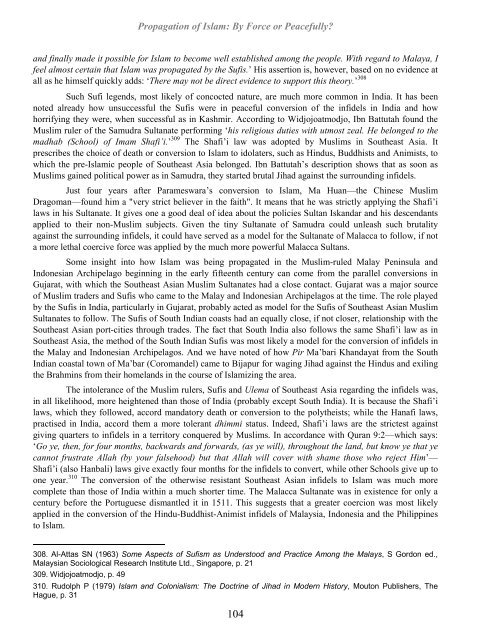islamic-jihad-legacy-of-forced-conversion-imperialism-slavery
islamic-jihad-legacy-of-forced-conversion-imperialism-slavery
islamic-jihad-legacy-of-forced-conversion-imperialism-slavery
- No tags were found...
You also want an ePaper? Increase the reach of your titles
YUMPU automatically turns print PDFs into web optimized ePapers that Google loves.
Propagation <strong>of</strong> Islam: By Force or Peacefully?and finally made it possible for Islam to become well established among the people. With regard to Malaya, Ifeel almost certain that Islam was propagated by the Sufis.’ His assertion is, however, based on no evidence atall as he himself quickly adds: ‘There may not be direct evidence to support this theory.’ 308Such Sufi legends, most likely <strong>of</strong> concocted nature, are much more common in India. It has beennoted already how unsuccessful the Sufis were in peaceful <strong>conversion</strong> <strong>of</strong> the infidels in India and howhorrifying they were, when successful as in Kashmir. According to Widjojoatmodjo, Ibn Battutah found theMuslim ruler <strong>of</strong> the Samudra Sultanate performing ‘his religious duties with utmost zeal. He belonged to themadhab (School) <strong>of</strong> Imam Shafi’i.’ 309 The Shafi’i law was adopted by Muslims in Southeast Asia. Itprescribes the choice <strong>of</strong> death or <strong>conversion</strong> to Islam to idolaters, such as Hindus, Buddhists and Animists, towhich the pre-Islamic people <strong>of</strong> Southeast Asia belonged. Ibn Battutah’s description shows that as soon asMuslims gained political power as in Samudra, they started brutal Jihad against the surrounding infidels.Just four years after Parameswara’s <strong>conversion</strong> to Islam, Ma Huan—the Chinese MuslimDragoman—found him a "very strict believer in the faith". It means that he was strictly applying the Shafi’ilaws in his Sultanate. It gives one a good deal <strong>of</strong> idea about the policies Sultan Iskandar and his descendantsapplied to their non-Muslim subjects. Given the tiny Sultanate <strong>of</strong> Samudra could unleash such brutalityagainst the surrounding infidels, it could have served as a model for the Sultanate <strong>of</strong> Malacca to follow, if nota more lethal coercive force was applied by the much more powerful Malacca Sultans.Some insight into how Islam was being propagated in the Muslim-ruled Malay Peninsula andIndonesian Archipelago beginning in the early fifteenth century can come from the parallel <strong>conversion</strong>s inGujarat, with which the Southeast Asian Muslim Sultanates had a close contact. Gujarat was a major source<strong>of</strong> Muslim traders and Sufis who came to the Malay and Indonesian Archipelagos at the time. The role playedby the Sufis in India, particularly in Gujarat, probably acted as model for the Sufis <strong>of</strong> Southeast Asian MuslimSultanates to follow. The Sufis <strong>of</strong> South Indian coasts had an equally close, if not closer, relationship with theSoutheast Asian port-cities through trades. The fact that South India also follows the same Shafi’i law as inSoutheast Asia, the method <strong>of</strong> the South Indian Sufis was most likely a model for the <strong>conversion</strong> <strong>of</strong> infidels inthe Malay and Indonesian Archipelagos. And we have noted <strong>of</strong> how Pir Ma’bari Khandayat from the SouthIndian coastal town <strong>of</strong> Ma’bar (Coromandel) came to Bijapur for waging Jihad against the Hindus and exilingthe Brahmins from their homelands in the course <strong>of</strong> Islamizing the area.The intolerance <strong>of</strong> the Muslim rulers, Sufis and Ulema <strong>of</strong> Southeast Asia regarding the infidels was,in all likelihood, more heightened than those <strong>of</strong> India (probably except South India). It is because the Shafi’ilaws, which they followed, accord mandatory death or <strong>conversion</strong> to the polytheists; while the Hanafi laws,practised in India, accord them a more tolerant dhimmi status. Indeed, Shafi’i laws are the strictest againstgiving quarters to infidels in a territory conquered by Muslims. In accordance with Quran 9:2—which says:‘Go ye, then, for four months, backwards and forwards, (as ye will), throughout the land, but know ye that yecannot frustrate Allah (by your falsehood) but that Allah will cover with shame those who reject Him’—Shafi’i (also Hanbali) laws give exactly four months for the infidels to convert, while other Schools give up toone year. 310 The <strong>conversion</strong> <strong>of</strong> the otherwise resistant Southeast Asian infidels to Islam was much morecomplete than those <strong>of</strong> India within a much shorter time. The Malacca Sultanate was in existence for only acentury before the Portuguese dismantled it in 1511. This suggests that a greater coercion was most likelyapplied in the <strong>conversion</strong> <strong>of</strong> the Hindu-Buddhist-Animist infidels <strong>of</strong> Malaysia, Indonesia and the Philippinesto Islam.308. Al-Attas SN (1963) Some Aspects <strong>of</strong> Sufism as Understood and Practice Among the Malays, S Gordon ed.,Malaysian Sociological Research Institute Ltd., Singapore, p. 21309. Widjojoatmodjo, p. 49310. Rudolph P (1979) Islam and Colonialism: The Doctrine <strong>of</strong> Jihad in Modern History, Mouton Publishers, TheHague, p. 31104


